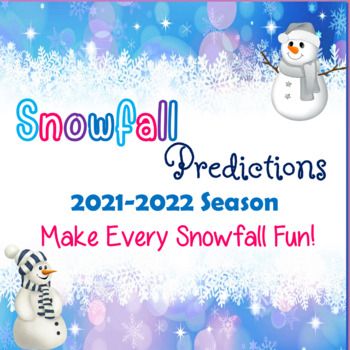Weather Predicting Predicting Snow Winter Snowfall - Digital Distance Learning
- Zip
- Google Apps™

Also included in
- An entire year of WEEKLY Computer Technology Lessons & Activities for 4th Grade. This bundle includes Computer Technology Lessons for Google Drive apps for a WEEKLY Computer Class or for classroom teachers wanting to teach Google Apps on a weekly basis.Each lesson/activity is approximately 35 miPrice $114.48Original Price $120.50Save $6.02
- An entire year of WEEKLY Computer Technology Lessons & Activities for 5th Grade. This bundle includes Computer Technology Lessons for Google Drive apps for a WEEKLY Computer Class or for classroom teachers wanting to teach Google Apps on a weekly basis.Each lesson/activity is approximately 35 miPrice $100.56Original Price $105.85Save $5.29
- An entire year of WEEKLY Computer Technology Lessons & Activities for Grades 3 - 5. This bundle includes Computer Technology Lessons for Google Drive apps for a WEEKLY Computer Class or for classroom teachers wanting to teach Google Apps on a weekly basis.Each lesson/activity is approximately 30Price $302.67Original Price $318.60Save $15.93
Description
Includes both Digital & Printable versions. Make every snowfall fun with this Snowfall Predictions activity. Lessons combine science, math, writing, and a friendly class competition EVERY time it snows for the 2022-2023 season!
Students will become meteorologists by predicting snowfall for the city they live in (nearest big city, or choose a city if you live in an area that does not receive snow). Living in the mid-west we get our fair share of snow and I created these activities to make every snowfall fun! Begin with the slide presentation (editable) to introduce the activities, students then research snow data (includes websites for the United States & Canada), students will make predictions using either a Google spreadsheet linked to a Chart or a printable copy for younger students. Includes a Google Form for students to enter the snowfall data to make it easy for teachers to download students’ predictions. Teachers record data in a Google spreadsheet (includes websites as well to obtain snow data) every time it snows. Announce the monthly prediction winner. Includes both in-class bulletin board display poster and virtual bulletin boards for displaying student predictions.
Snowfall Predictions Includes:
- Snowfall Predictions Presentation (Google Slides - EDITABLE)
- Snowfall Predictions Student Directions PDF
- Snowfall Predictions Spreadsheet
- Snowfall Predictions Printable
- Google Form Snowfall Predictions
- Snowfall Data Spreadsheet
- Writing Activity Digital
- Writing Activity Printable
- Virtual Bulletin Board Display (4)
- Printable Bulletin Board Poster
- Snowfall Prediction Winner Slide
- Teacher Directions
Yearly Updates!








